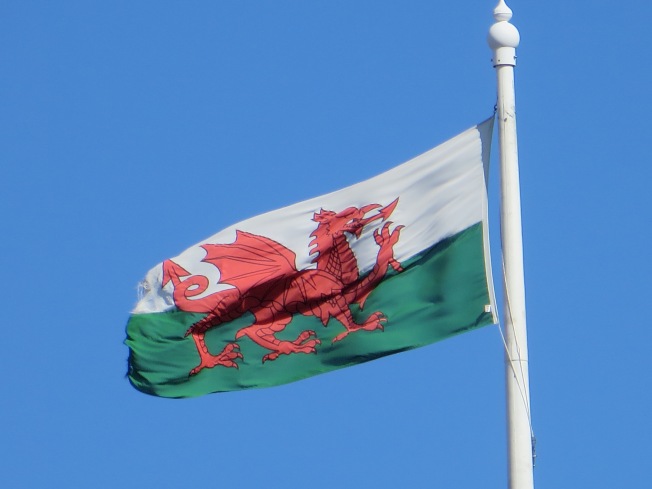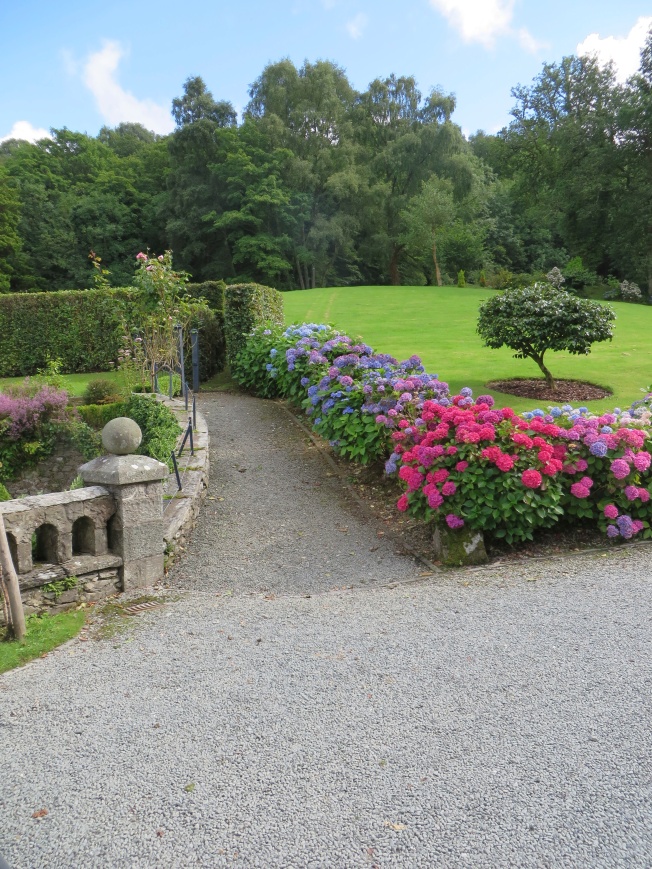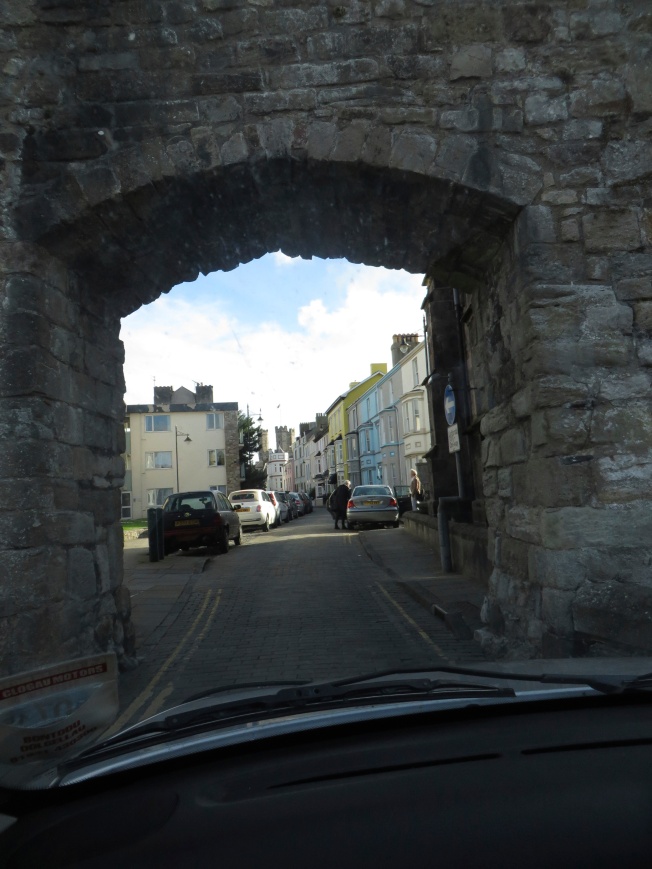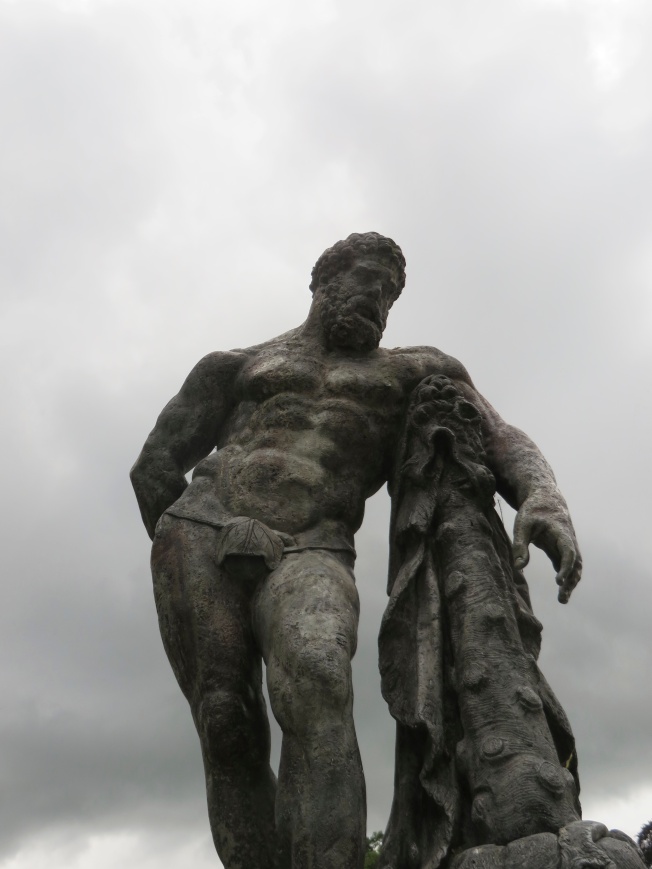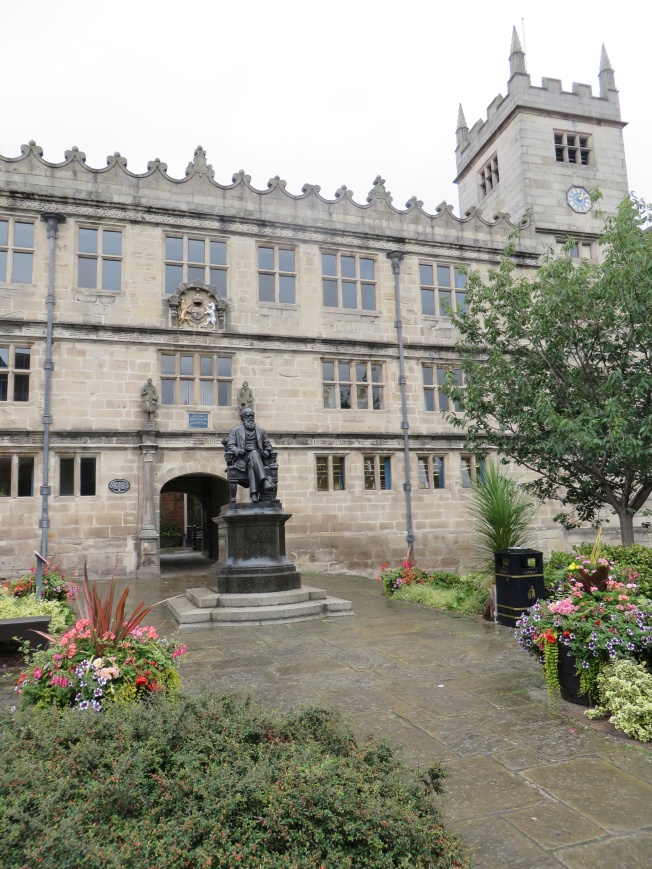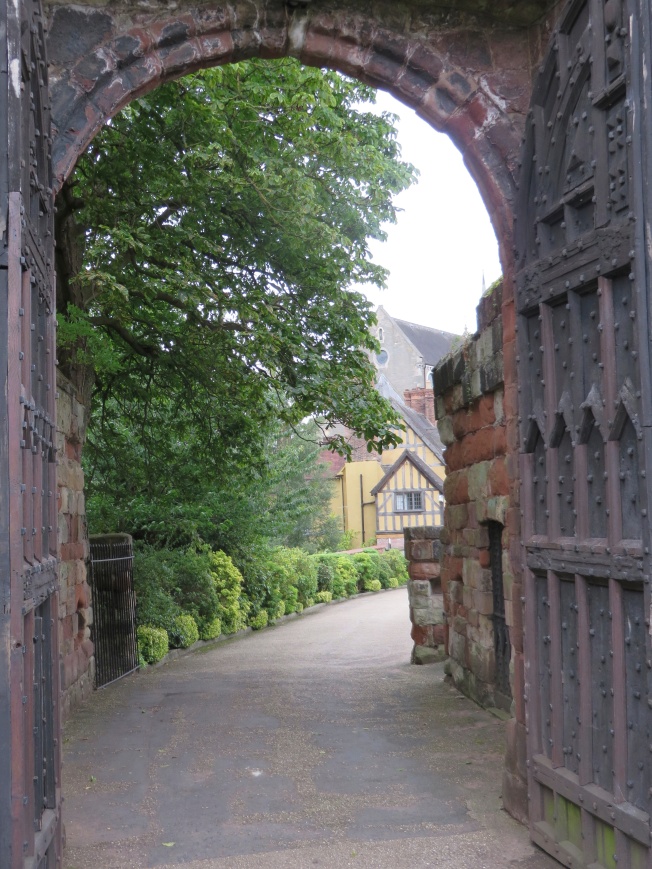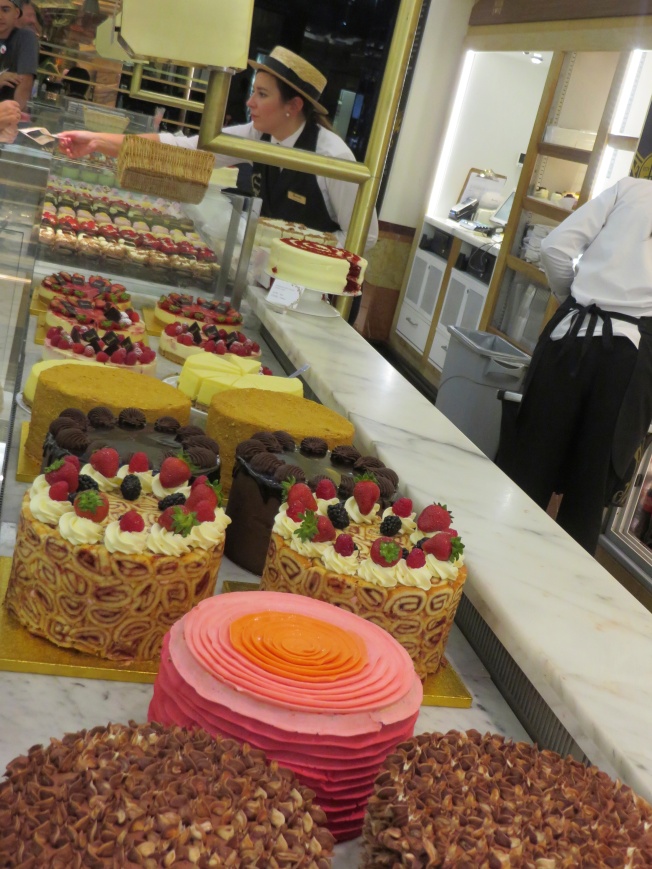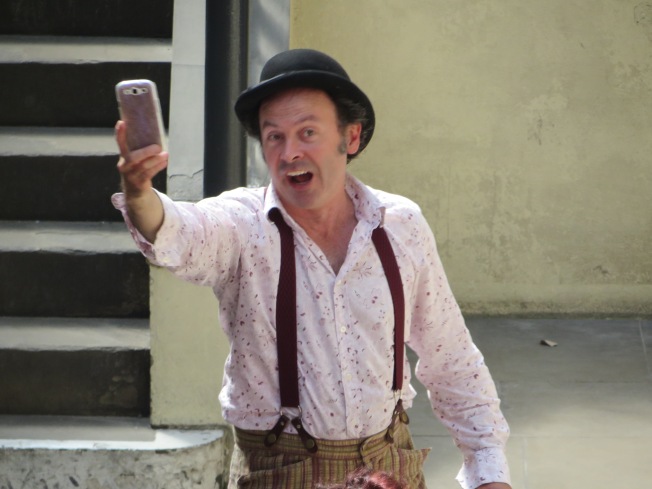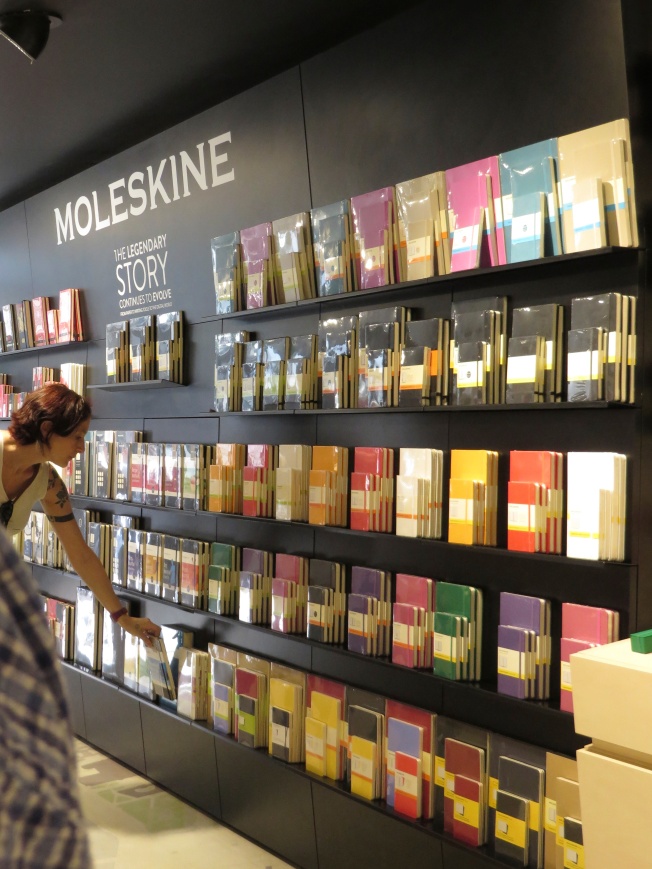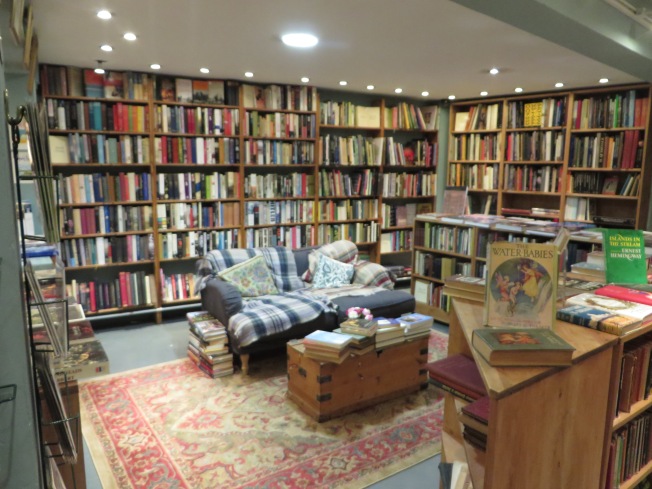And then there is Wales.
Other than a deep love for Gavin & Stacey, which is set in Wales and that I watch at least twice a year and quote daily, I leave Shrewsbury with no idea of what to expect. This trip has been so ill-planned that I haven’t had time to do my usual research before leaving, wherein I’d meant to read up on the history, immerse myself in some Dylan Thomas (including re-watching one of my favorite Christmas movies, the depiction of his poem “A Child’s Christmas in Wales”), study the guidebooks carefully so I’d arrive in Wales ready to feign a previous acquaintance. Z has been in Wales once on a rugby tour, though his memory of where he was and what he did there is too hazy to offer much insight other than an amusing anecdote about getting spooked in a graveyard of movie-quality mist and eeriness, a quality custom-built into Wales I’m beginning to suspect. We sit on the platform at Machynlleth in the dark, waiting for our connecting train, huddled together in the cold as we try to figure out how a person should say “Machynlleth.” The woman next to us mentions her stop at Aberdovey, and it sounds like Abu Dhabi, and I wonder exactly where this train will be taking us.
I’m not being dramatic: as we sit there in the dark with the moon the primary source of light, I fully expect to be attacked by werewolves. I’ve needed the toilet for the last twenty minutes, but my brief attempt to find it on the other side of the station where it is even darker left me scurrying back to Z, convinced that I should hold it until I get on the next brightly lit train that will be taking us to Barmouth, a seaside resort on the Atlantic, and Z’s family friend, July. I snuggle in next to Z and feel very content despite my full bladder and our impending evisceration by werewolf. The Abu Dhabi woman tells us that the next leg of the journey is the best, most beautiful bit, but because it’s so dark, we’ll miss the mountains, miss the descent across the estuary, and into Barmouth. Ah well, Z says. Next time. I like hearing this. I am not a person who easily goes to a place just the once. I like to return.
We are no sooner off the train than July envelopes us in bear hugs. We haven’t seen her since our wedding five and a half years ago (which was also when I met her), and I love the sensation of instantly being cared for. For the next five days I won’t be in charge of what we see and do. With July, you know you’ll have a good time and it’s nice to have her at the helm. I can’t say I know anyone like her. I suspect she’s never met a stranger and she’s never said no to any sort of potential adventure. Though she is English, she became a part of Z’s world when he was a teenager and she was teaching with Z-ma in Zimbabwe before heading off to work in Botswana, while Z-ma and Z-pa looked after her children who were in school. She was working in Libya when she got the notion to open a tea room in Wales, and she’s been ensconced in Barmouth now for twenty years, though she has retired to travel. It is no surprise to look at Facebook on any given day and see that July is some place on the globe you’ve heard little about, always with a new set of friends she’s made.
And also, she wears purple every day, and it’s really hard for me not to like a person who has that particular signature color.
She drives us around the few streets of Barmouth to her place in the upstairs of a 300 year old building on the main drag. Because the place is “listed” (in the U.S. it would be on the historic register), when she remodels or makes structural changes, she has to get permission and is sometimes denied, so the front of the building will remain pink indefinitely. The space couldn’t be more delightful. It is crooked and leany and has low ceilings in some places and high gabled ceilings in others. Black crossbeams go across the ceilings and I suddenly want to write on parchment with a quill pen. The trek from the bedroom we are sleeping in to the bathroom requires that we duck so we don’t conk our heads.
In short: it’s exactly the sort of place you want to stay when you are in Wales.
July has gone out of her way to be an excellent host. We’re greeted with a basket of fruit and a bowl of crisps (behind which is sitting the children’s book my mother illustrated). Towels are laid out for us like we are staying in a guest house, and before we lug our suitcases (our blasted, blasted suitcases) up the stairs, she is making us late-night eggs since we had wrongly assumed there’d be dinner to be had on the train or at the werewolf-infested train station. While she talks to Z in the kitchen, I poke around her space, looking at the stacks of books I have either read and loved or want to read, admire her artwork, imagine my life if I were living it here. Her decorating sensibility is geared to entertaining and comfort. Though her living room and dining room is shared, she’s chosen furniture that can expand and retract as needed based on the number of people present. In one corner, there is a reading chair that she tells me sits on a ley line. I’ve never fully understood ley lines, but when I sit there, I do feel strangely content.
Ley line or not, my favorite spot in the whole space is the cushion in the wide, deep-set kitchen window where you can look down on the happenings of Barmouth while talking to Z and July.
While in Wales, I have my first experience with the British National Health Services because a couple of mosquito bites have gone wonky. My left hand is so red and swollen that I remove my rings before they get stuck. When Z says, “I don’t like the look of that,” I agree to see the doctor because the last time Z said, “I don’t like the look of that” and I ignored him, I ended up with a scorching case of shingles and a threat of hospitalization. July explains that because people go too frequently to the doctor—which is paid for by the state for everyone—there is a new rule that unless it is an emergency, you visit your local pharmacist first to have your ailment assessed, and then you are told whether going to the doctor is necessary. For whatever reason, I feel more ridiculous stretching out my hand to the too-young pharmacist so he can survey my bites than I do actually going to a doctor. Surely this poor man has better things to do like dispense drugs. He suggests the bites are on the verge of being infected, and if it isn’t better in a day or so, I should go to the doctor. The next day, it is no better, is maybe worse, so we make an appointment. We do a little sightseeing before the appointment, me periodically checking in on the redness and swelling, and then, as we drive to the doctor’s office my hand suddenly looks nearly normal. My rings fit easily on my finger. The redness has shrunk down so it’s just around the two bites. By the time the nurse looks at my hand, I feel like a fool. I am one of the idiots who has jammed up the National Health Services with a mosquito bite so people with real conditions now have to see a pharmacist first.
July, who never has to pay for healthcare, is outraged when they charge me 30 pounds because I’m not a taxpayer in the UK. Z and I look at each other as we do the calculation with the sub-par exchange rate that makes the UK expensive for Americans and realize that even so, this is the cheapest doctor’s visit I’ve ever had.
After our short, five-day stay with July, if you asked me what is in Wales, in no particular order, this would be my list:
- more sheep than I’ve ever seen anywhere (and I’ve been to Ireland seven times)
- the lushest, greenest pastures and hillsides I’ve ever seen (and I’ve been to Ireland seven times)
- charming villages and towns
- castles
- tea rooms and cafés at every turn
- The Little Trains of Wales
Every night, it rains; every morning, we wake up to a drizzle. Miraculously, by the time breakfast is finished and we’ve made our way to the car, the rain has dried up and we have nary a shower to impede our sightseeing, almost as if the tourist board has made an arrangement with Mother Nature.
And the rain is put to good work. As we careen around mountains and down into valleys, I begin to worry that when we get to Ireland Z will be unimpressed because this is truly the greenest, most verdant landscape I’ve ever seen. It’s also worth noting, the roads are some of the most narrow too. At one point, we come face to face with a driver on a narrow mountain pass and we have to inch slowly past each other with our side of the road being the one most likely to deposit us down the mountainside. I momentarily think, We’ll die today, and then quickly amend, At least it will be beautiful death.
July is a master tour guide. Each day is the perfect mix of driving, sightseeing, and stuffing our faces with scones and lemon drizzle cake in some stately home she’s been going to for years, the proprietor of whom is a personal friend or at least familiar with July. In one place in the mountains, the owner’s children offer to show us their chickens and rabbits. In another—the space where July’s daughter got married—renovations have been made that July is not entirely sure she approves of. In another, the server teaches me how to say “Mabinogion”, the name of the earliest prose literature of Britain.
My favorite of the spots we go, Penmaenuchaf Hall, is the sort of house I feel certain I must have lived in in a former life (admittedly, probably as a scullery maid who was oft chastised for her poor quality work) because each room is so comfortably and beautifully appointed. While we wait for our tea—served on dishes I find photograph worthy—I sneak into the adjoining library and peer at the books.
After tea, we wander around the formal gardens, sniffing the lavender, getting a lesson on the different types of heather from July. I try at length to take a picture of the hydrangea that line the driveway—a pantheon of color the likes of which seem unwilling to be captured in a photo. I want to live here. Or maybe at least sell a few essays so we can stay for a few nights and have meals served to us on that china.
As we travel around, we weave in out of some of the most picturesque villages I have ever seen, most of which could easily be inhabited by hobbits or other characters from some mythical tale, so charming are they. July has to give me pronunciation lessons at each one, as the string of consonants run together make no sense to my brain or tongue.
One day, we make our way to Portmeirion, a tourist village/resort that was fifty years in the making and has been used as set for TV shows and movies, most notably for The Prisoner, a series from the 1960s. It is the quirkiest, most brightly colored place I’ve ever seen—it is reminiscent of Main Street at Disney World, only this is even brighter, looks more like something on the Italian Riviera, and has a jumble of items salvaged (or created) from around the world.
Trompe l’oeil is used to trick the eye into believing a mural on the side of building is a bank of windows on a villa. Small statues, cleverly used paint, and forced perspective make buildings look larger (or sometimes smaller) than they actually are. There is a huge golden Buddha sitting under a loggia, a town hall despite the fact that this is a resort with no actual residents, ornate doorways that lead nowhere, a ship in the harbor that is really a retaining wall. As Z and I walk around, wrinkling our brows and occasionally mouthing “what is this place?” to each other, July (and everyone else we talk to) is clearly delighted by it. Eventually, we settle into the fantastical kookiness, though perhaps the most surreal moment for me is when I walk into a bookshop in one of the brightly colored “village” shops, and the clerks are speaking Welsh to each other, reminding me again that I am not in some fairy tale Mediterranean village at all but instead clinging to the coast of Wales.
In every guidebook, in the tourist literature, and on many of the road signs we are pointed to one or another of the Little Trains of Wales. At first, when July refers to them as such, I think it’s a term of endearment that she’s coined, but it turns out this is what they are called. They are the narrow gauge railways built to transport slate that have been repurposed for tourism. Because we have a notion that the trains will be full of the badly behaved children we were surrounded by at the Tower of London and because we still haven’t quite recovered from that experience (seriously, the kids were horrid and left me feeling like the witch from “Hansel and Gretel” without an oven to shove them in), we opt not to ride one of the national treasures.
The affection with which everyone speaks of the trains and of the different scenery each line affords, however, leaves me wondering if we’ve made a mistake. But then we start touring castles and I no longer care about trains large or small.
All of the castles we visit were part of Edward I’s “iron ring”, an impressive collection of castles around Wales, built within about a three-year period during the 13th century, meant to keep the Welsh in their place, let them know who was in charge, and sure, also ward off foreign invaders. But mostly, they were about the Welsh. Because of the time frame, the four castles we see are all reminiscent of each other so when Z asks which one I like best, it’s inevitably whichever one I’m standing in front of. That said, they are all amazingly unique. Our first, Harlech, is the closest to Barmouth, and the thing that is most striking to me is that we’re driving down the road and then boom, there it is in front of us, high on a hill letting the whole world know it is not to be trifled with. When it was built, the sea likely brushed up against the rocks on which it sits, but now the village of Harlech has expanded beneath it.
Later, as we stand on the ramparts looking down, I see a school, people going to shops, living their lives completely unfazed by what must have, when the castles were inhabited by English nobility and soldiers, made the Welsh either quake in their boots or feel seriously pissed off about the liberty-taking invaders. Though it is a ruin, the castle is in remarkable condition; the walls and towers stand nearly to their full height. Z and I walk along the ramparts, feeling a little dizzy as the wind whips us around. I try to snap a shot of the be-dragoned Welsh flag and discover later that it is nearly in tatters from that vicious Atlantic wind. This castle is my favorite.
The next castle we visit, also my favorite, is Conwy, which still has the medieval wall surrounding the village it is attached to. As we approach from across the bridge leading into the village, it strikes me that Conwy looks like the castle most of us try (and fail) to build at the beach. It sits majestically by the water and I can’t wait to get inside. Unlike Harlech, this castle was “slighted” during Cromwell’s time, which means some of the structures were partially demolished so it couldn’t be used again as a fortress. As Z and I walk around inside while July has tea in a nearby café, I can’t help hating Cromwell for this (as well as some other sins committed against Celts here and across the Irish sea).
Inside, you can see arches on what would have been the chapel windows, you get a sense of how grand the royal apartments might have been, how horrifying the drop into the prison cells below. It seems a tragedy to me that it wasn’t maintained. Z and I are also impressed with the small signs that give us just enough information without distracting us from the views (there are no piped in animal or battle noises here, like at the Tower of London!). In this space, it is not difficult to imagine a Guinevere or an Arthur living a life. When we leave, July drives around the narrow streets that weave in and out of the village walls. It’s a place where I wouldn’t mind returning.
We are too castle-greedy on this day, and when we finally make it to the famous Caernarfon Castle in another walled village, the castle has closed.
I’m a little disappointed because this is where the Prince of Wales had his investiture in 1969, and I’ve seen photos of that ceremony. It is formidable with it’s large polygonal towers, and it is no surprise that this is where Edward I determined to make his son the first Prince of Wales, to remind the Welsh that they were no longer their own people. It is so odd to me that if I see castles in England, they seem romantic—fortresses to protect that sceptered isle set in a silver sea. But in Wales, I can’t shake the feeling that the English were just thumbing their noses at the people they’d conquered. If you are Welsh, living in 21st century Wales, do you see those castles as a national treasure, or does it chafe a little all these centuries later?
I have an idea how I’d feel.
The last castle, Beaumaris, I am sure will be my favorite. The guidebooks I’ve barely cracked mention that it is the most technically perfect castle in all of Britain. It is symmetrical, a sort of castle within a castle, and July agrees that it really is gorgeous. I can’t wait. We save seeing it for our last day because it is on the Isle of Anglesey—the place Prince William and Kate Middleton lived right after they got married—and we’ll be headed to the ferry that will carry us to Ireland. Because we are running a little late, we only do a drive-by of Beaumaris. The road to it is twisty and you can’t see around the bends, so at each turn, I’m sure I will look up and there it will be, this example of castle perfection. The anticipation is almost more than I can stand. And then suddenly, there it is, and all I can think is:
huh.
It has a lovely moat, gorgeous round towers, I can imagine what it looks like on the inside because I’ve seen an aerial view in one of my books. But it is so short. There is nothing about it that is formidable. Earlier in our trip to the ferry, July decided to drive by some standing stones near her house. I was expecting Stonehenge, but when we got to a rugby pitch, there at the side of it were stones no higher than an average fourth grader. I was instantly reminded of the miniature Stonehenge created for the band in This is Spinal Tap when the band mistakenly commissions an 18 inch replica instead of the 18 foot one they were imagining. This stone circle would have been perfect on the grounds of the vertically challenged Beaumaris. July offers to stop and Z and I wave her on. Maybe next time we don’t have a ferry to catch we can be wowed by the technically perfect interior and I’ll issue a retraction so Beaumaris can become my favorite too.
The road flattens out in front of us. The trees become short and scrubby and the mountains can only be seen in the rear view mirror as we get closer to the ferry port. I have mixed feelings about leaving Wales and July. It’s been such a wonderful respite to be with her and this gorgeous little country has exceeded my expectations. But Ireland has owned me since I first stepped foot there in 1999, and while we make the final stretch to Holyhead and the ferry, all thoughts of English royalty, castles big and small, and the Little Trains of Wales dissipates.
The pipes, the pipes are calling.
